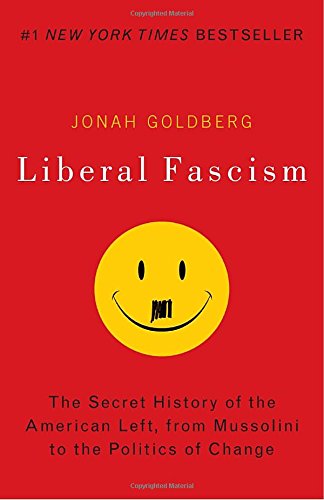A Brief Book Summary from Books At a Glance
About the Author
Jonah Goldberg is a columnist for the Los Angeles Times and a contributing editor to National Review. A USA Today contributor and former columnist for the Times of London, he has also written for The New Yorker and the Wall Street Journal.
Introduction
In Liberal Fascism, Goldberg argues that fascism is not a phenomenon of the right, but rather of the left. He documents the fascism of American Progressivism and its support of European fascism before WW2. Goldberg maintains that contemporary American liberals still bear the earmarks of fascism, with their desire to implement a totalitarian (but benevolent) rule over the nation (for its own good).
Table of Contents
Introduction: Everything You Know about Fascism is Wrong
Chapter 1 Mussolini: The Father of Fascism
Chapter 2 Adolf Hitler: Man of the Left
Chapter 3 Woodrow Wilson and the Birth of Liberal Fascism
Chapter 4 Franklin Roosevelt’s Fascist New Deal
Chapter 5 The 1960s: Fascism Takes to the Streets
Chapter 6 From Kennedy’s Myth to Johnson’s Dream: Liberal Fascism and the Cult of the State
Chapter 7 Liberal Racism: The Eugenic Ghost in the Fascist Machine
Chapter 8 Liberal Fascist Economics
Chapter 9 Brave New Village: Hillary Clinton and the Meaning of Liberal Fascism
Chapter 10 The New Age: We’re All Fascists Now
Afterword: The Tempting of Conservatism
New Afterword: Barack Obama and the Old Familiar Change
Summary
Introduction: Everything You Know about Fascism is Wrong
The term “fascism” is thrown around with great frequency, but it is very difficult to get a clear definition. Liberals tend to apply fascism to all of the ideas of their opponents, even though liberalism in America comes from progressivism, which had more in common with Mussolini and Hitler than conservatives do. Fascism is not the opposite of communism, and it is a phenomena of the left-wing not the right-wing. Liberalism’s moralistic social crusade to create Utopia is very similar to the attitude of the Nazis and Communists. Progressives had agreed with fascist policies leading up WW2, but afterwards they tried to distance themselves from it and to associate it with the right. The US administrations of Wilson and FDR were fascist through and through. Liberals desire to create a state that benevolently guides every aspect of life for the greater good of society, where they alone know what is best and have power to enforce their ideology. Of course liberals are horrified by the Holocaust, and fascism in America will not look like Hitler’s regime, but there are important points of philosophical and political agreement between them (although it must be stressed that nobody on the left in America supports Hitler’s atrocities). Progressives desire to produce a utopian nation and global state with centralized power. For a working definition of fascism, we will say that “Fascism is a religion of the state.” It is totalitarian and brings every area of life under the control of its political vision, demonizing all who disagree: American liberalism is fascist.
Chapter One
Mussolini: The Father of Fascism
Fascism arose in Italy before Germany, and many in America were pro-fascist at this time (a time before it had any connection to anti-Semitism and WW2). Mussolini was widely praised by Western liberals for his dictatorial turning of Italian society in a progressive, socialist-fascist direction. Fascists wanted to move beyond liberal democracy with its foundation in natural law and religious traditions, bringing nations to maturity under their enlightened policies. Mussolini mocked Christianity and declared that religion was the enemy of fascist liberalism. Lenin and Mussolini were mutual admirers. Mussolini was proclaimed the leader of socialism before the leader of fascism. Shaping a mythological narrative that people believe—regardless of whether it is based on facts—was an important goal and required committed avant-garde leaders. The French Revolution was anti-religion and exalted the state, even though that required putting to death thousands of people who disagreed with the ideology of the elite: this same approach to totalitarianism was found in Italy, Germany, and the Soviet Union. The state became a god, and Mussolini declared that fascism was a religion. When communists tried to depict fascism as right rather than left, Mussolini protested that he was always a socialist. He came to see that there are different kinds of socialism, and he moved towards a populist version, backed up with violence and force. Pragmatism and getting things done—truth is what works—was a key concept. Mussolini coined the term “totalitarianism,” since nothing was outside of his state’s control.
Chapter Two
Adolf Hitler: Man of the Left
Scholars debate whether or not Nazism was fascist, which just shows how misunderstood fascism is at a popular level. Mussolini derided Nazism from the beginning for its racism, and Nazis derided Mussolini for being a pro-Jewish fascist. Hitler used anyone that he could, and there were conservatives and industrialists who were supported by him, but the left has tried to erase the many leftists who were intertwined with Hitler’s politics. The Nazis destroyed the left, but they also replaced it as. . .
[To continue reading this summary, please see below....]The remainder of this article is premium content. Become a member to continue reading.
Already have an account? Sign In
